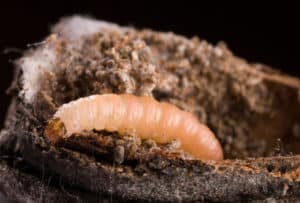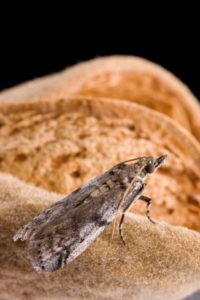KeyPlex AWP uses unique mode of action of nature’s own essential oils.
Navel orange worm (NOW) is an ever-present and often devastating pest for nut growers. Proper orchard management and sanitation is the most important and effective way to reduce NOW populations. Insecticides are often used as well, but NOW is adept at developing resistance to conventional chemistries. On top of that, some of the insecticides remaining in the NOW toolbox have been removed by regulating agencies. In some years, even in well-run orchards, damage from NOW can amount to 10% of the crop, meaning a loss of hundreds of dollars per acre.

A navel orange worm larvae feeding inside a nut. Photo: Peggy Greb USDA ARS
Just to add insult to injury, NOW-infested nuts, or even those just slightly damaged, are more vulnerable to infection by Aspergillus fungi, which produce aflatoxins – known carcinogens and a food safety hazard.
Mites are also a consistent problem with nuts, especially almonds. Mites, including Pacific spider mite, can cause defoliation and related stunting on non-bearing trees, and sunburn to fruit in mature trees, resulting in yield loss.
Natural Compounds Combat Resistance — Offer Novel Modes of Action
Clearly new methods of control are needed. KeyPlex is launching KeyPlex AWP, an essential oil product customized specifically for problematic pests in nuts. Essential oils are natural compounds produced by plants to defend themselves against diseases and pests. As complex extracts, they contain many pure compounds with multiple modes of action that make development of resistance impossible.
NOW in a Nutshell
Lifecycle
Damage
Control
|
“We specifically customized this product for nuts, with a focus on the navel orange worm, and it originated with efficacy data we generated on a surrogate insect in the same family – the Indian meal moth,” says Steve Bessette, Vice President of the Botanicals division at KeyPlex. “We selected different modes of action and put them together to maximize performance. KeyPlex AWP provides knock down and kill on contact, but it is also repellant. It’s not a mating disruptor, but it does deter oviposition.”
Because of this repellency, Bessette recommends spraying early to deter the females from laying eggs in the first place.
“Many folks using our essential oil products spray the borders of their groves to prevent the insects from coming in from neighboring orchards, as well as the crop itself.” Bessette says. “For almond growers, we recommend March and April. The end of April and early May is when the first instar starts to feed and bore into the nut. Once that happens, the nut is damaged.”

Navel orange worm adult. Photo: Peggy Greb USDA ARS
The active ingredients in AWP are a complex mixture of thyme oil, cinnamon oil, rosemary oil, geraniol and sesame oil. Bessette and his team spent more than a decade and $15 million dollars researching essential oil technology, identifying the pure compounds and mode of action responsible for the insecticidal activity, along with the synergies between them.
“With KeyPlex AWP, we’ve taken three distinct modes of action that we’ve identified from the plant essential oil compounds and combined them into a single product,” Bessette says. “So effectively, this has a triple MOA completely different from any other chemistry in the nut market. It will be far more difficult for an insect/mite to develop resistance to this product than to a single molecule.”
To manage resistance, university Extension researchers, the California Almond Board and other experts all recommend rotating modes of action and not spraying twice with the same one. Because of its entirely different and multiple MOA, KeyPlex AWP offers growers another effective option. It can be tank-mixed with conventionals or used as a standalone in rotation. In the classification system developed by the Insecticide Resistance Action Committee (IRAC), KeyPlex AWP is in classes 2 and 19, along with a further enzyme inhibitor.
Bessette says there may be some newer chemistries in the pipeline, but they are all single molecules that will eventually experience resistance. Having other methods of control with different modes of action will help to preserve the efficacy of those products as well.
Flexibility in Application Timing Another Key Benefit
Another key benefit of using essential oil-derived products such as KeyPlex AWP is that they are EPA-Exempt, California-Exempt, food-grade materials. As such, they have zero preharvest interval (PHI) and zero worker re-entry interval (REI).
“All of the conventional treatments available either have a REI and/or PHI of some kind, which creates some administration issues,” Bessette says. “You can spray at any time with KeyPlex AWP.
Essential oils target multiple receptors, including the octopamine receptor in the insect – a receptor mammals, including humans – don’t have. Bessette says while knowledge of the octopamine receptor and its possible use in developing insecticides is not new, developing a safe product to target such a receptor was not easy.
“Octopamine was identified decades ago and was the target of the early formamidine group of insecticides like chlordimeform,” Bessette says. “But because these formamidines had nitrogen-containing compounds, they were unsafe for the environment and for people, so they were removed from use. The essential oil compounds contain similar chemical structures to the octopamine neurotransmitter, and therefore bind at that site. Even though this information was identified by KeyPlex, the essential oil active ingredients still had to reach their target. Half the battle for us was figuring out how to deliver the active ingredients effectively through the insect cuticle to the target site. We worked hard on the delivery side of it – 50% of performance is the active ingredient blend, the other 50% is getting it to where it needs to go.”
Efficacy data on mites was previously generated with the Almond Board of California. Trial data on NOW will be available at launch, Bessette says.
